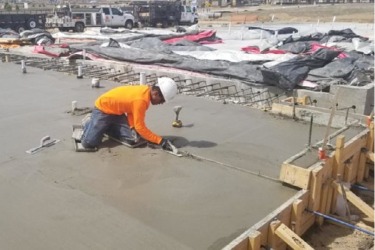There exists two ways to pre-stress the concrete in your building project: pretension and post tension. Pretension happens at the precast facility, where the tendon assembly is placed into the concrete form and stressed at the factory to engineered specifications. In the latter, you set the ducts, anchors and strands — together making up the tendon assembly— on-site prior to the concrete pour, after which, you stress the tendons to the required tolerances.
While on-site post tensioning allows for large slabs, too big to be transported to the job site, and for architectural configurations beyond the scope of precasting machinery, tendon stressing requires a certain finesse. It must be accomplished by experienced personnel or you face the prospect of failure. When stressed tendons fail, so can your concrete structure. In worse-case scenarios, a snapped strand can kill. So, why do you want to build with prestressed concrete, and how do you know the tendons were stretched to the planned degree of tension?
WHAT IS PRESTRESSED CONCRETE?
By prestessing concrete, you combine the advantages of both steel reinforcement that resists tensile pressure and compression that makes the concrete stiffer and better able to withstand both its dead load and anticipated live loads.
To do this, you embed steel cables, or strands, in an undulating pattern into the concrete with the ends anchored to one side. Once the concrete has cured to a certain degree, you pull the live ends of the strands with a hydraulic jack which then imparts internal compressive force outward at the peaks and valleys of the steel cables. Then, by anchoring the stretched strands to the opposite edges of the slab or beam, they attempt to retract. This action against the side of the slab pulls the concrete inward, compressing it against lateral forces. In the end, you’ve converted tensile stress into counteracting compressive stress before any loads are applied. By prestressing, you need considerably less rebar, can span greater distances without support and use thinner pours.
HOW DO I KNOW ALL THE TENDONS WERE STRETCHED?
To successfully build with prestressed concrete, your engineer will have calculated all the stress tolerances to an exacting degree. These designs usually have little room for error. Therefore, achieving the proper tension can be pretty tricky. Untrained concrete crews will not have the experience to even properly set the tendon ducts, or sheathing, for the steel strands, much less stress them to the designed degree of tension. Most likely, you will need to hire a crew experienced in prestressed concrete. Even then, how will you know they performed as desired? After all, if anything goes wrong, you could be on the hook for workplace injuries or death or, down the road, for structural failure.
DILIGENTLY OBSERVE THE LAYOUT
Because the shop drawings may not render exactly as engineering plans dictate, you must rigorously compare the two. Where shop drawings diverge from the original blueprints, consult the responsible engineer for guidance and follow the engineer’s instructions exactly.
MARK STRANDS PRIOR TO TENSIONING AND INSPECT EACH AFTERWARD
Prior to tensioning, the strands should all be marked with paint at a uniform distance from the anchor plate. After stretching, the marks will indicate whether each tendon was elongated, and measurements will verify whether the proper force was applied. In this fashion, you can tell if any strands were missed.
Any flaws in the design could manifest as snapped tendons or break outs, either immediately or within the early life of the structure. Too little tension, and the loads will soon cause deflection. Too much tension can also cause deflection of their own; however, because the post tension strands are buried and out of sight, issues may go unnoticed right up until a failure occurs.
The best way to avoid disasters in prestressed concrete members is to have the most professional and experienced company guide you through from design engineering to on-site stressing. Barton Supply leads the Colorado construction industry in post tension concrete expertise. Don’t leave your project success in the hands of the less experienced. Give us a call today to discuss whether post tensioning is the right fit for your construction goals.
